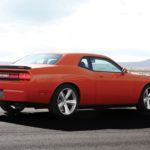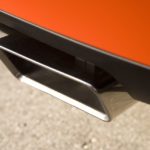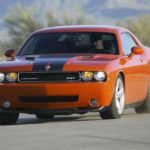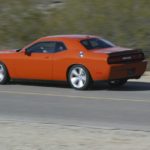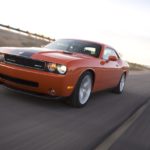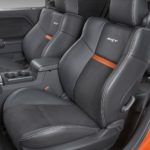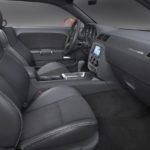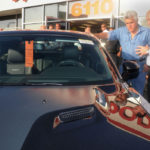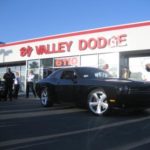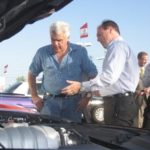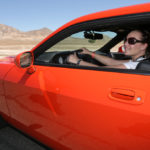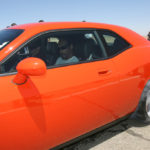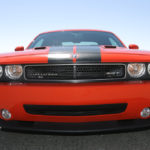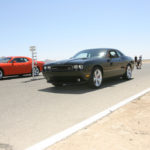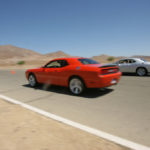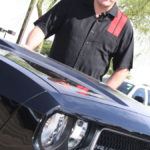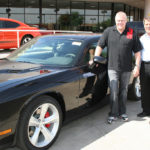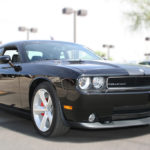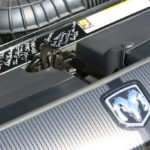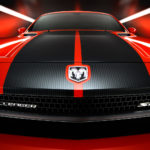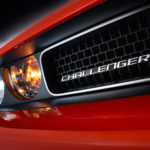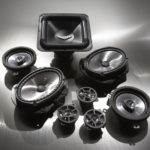2008 Dodge Challenger SRT8 mehr Details inkl Video
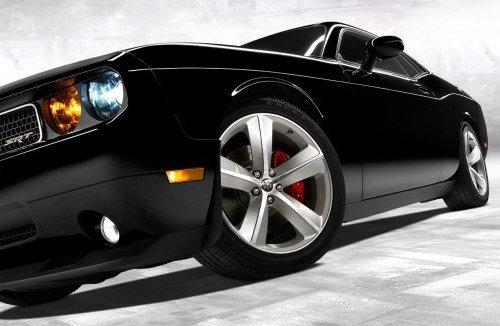 Chrysler macht anscheinend alles die Herzen von uns Autofans höher schlagen zu lassen. Wer es wie ich kaum erwarten kann den ersten Challenger in Bewegung zu sehen und vorallem zu hören … der sollte jetzt einfach mal weiter klicken. Es gibt ausserdem noch mehr Fotos vom neuen Dodge Challenger zu bestaunen! Viel Spaß.
Chrysler macht anscheinend alles die Herzen von uns Autofans höher schlagen zu lassen. Wer es wie ich kaum erwarten kann den ersten Challenger in Bewegung zu sehen und vorallem zu hören … der sollte jetzt einfach mal weiter klicken. Es gibt ausserdem noch mehr Fotos vom neuen Dodge Challenger zu bestaunen! Viel Spaß.
2008 Dodge Challenger Debut
Passion Meets Passion
2008 Dodge Challenger in motion
Dodge Challenger – It’s On
Dodge Challenger Chicago Motor Show 2008
PRESS RELEASE COLLECTOR’S EDITION 2008 VOLUME 1 FEB 08 MUSCLE CAR ALL-NEW 2008 DODGE CHALLENGER SRT8 THE ICONIC MODERN AMERICAN MUSCLE COUPE RETURNS AFTER 35 YEARS OVERVIEW THE ULTIMATE MODERN AMERICAN MUSCLE COUPE ALL-NEW 2008 DODGE CHALLENGER SRT8
The return of the iconic Dodge Challenger brings what pony car fanatics crave: ground shaking performance, unmistakable design cues reminiscent of the original Challenger, world-class ride and handling characteristics and benchmark braking. On top of that it features a wide variety of modern amenities and technology designed to delight a new generation of driving enthusiasts. „The all-new Dodge Challenger SRT8 is engineered to give customers everything they want in a modern muscle machine,“ said Mike Accavitti, Director – Dodge Brand and SRT Global Marketing, Chrysler LLC. „The new version of Dodge’s American classic boasts tire-smoking performance and head-turning design while offering a wide array of state-of-the-art technology, such as GPS navigation, ‚Keyless Go‘ entry, a MyGIGâ„¢ infotainment system and UConnect hands-free communication.“ Developed by Chrysler’s in-house performance engineering organization, the 2008 Dodge Challenger SRT8 was engineered with a focus on the five pillars of every SRT vehicle: bold exterior design that resonates with the brand image, a race-inspired interior, world-class ride and handling across a dynamic range, a standout powertrain and benchmark braking. Dodge will offer the limited-edition 2008 Dodge Challenger SRT8 in three colors: HEMI® Orange, Bright Silver Metallic and Brilliant Black Crystal Pearl Coat. Each two-door, rear-wheel-drive coupe will be produced with a numbered dash plaque, carbon fiberlike hood stripes and will be powered by SRT’s 6.1-liter HEMI V-8 engine that boasts 425 horsepower and 420 lb.-ft. of torque. With a U.S. Manufacturer’s Suggested Retail Price (MSRP) of $37,995 (including $675 destination), the all-new 2008 Dodge Challenger SRT8 arrives in Dodge showrooms this spring. The 2008 Dodge Challenger SRT8 vehicles will be manufactured at Chrysler’s Brampton, Ontario, Canada assembly plant. Performance targets for the all-new 2008 Dodge Challenger SRT8 include a 0–60 mph time in the low 5-second range, 0–100–0 mph in less than 17 seconds, a ¼-mile elapsed time of less than 14 seconds, 60–0 mph braking distance of approximately 100 feet, and a skid pad performance of 0.88 g. DESIGN A CLASSIC AMERICAN MUSCLE CAR
The all-new, five-passenger 2008 Dodge Challenger SRT8® captures the emotion of the original two-door, rear-wheel-drive Challenger, but with an updated twist. „Our designers wanted to capture the mind’s eye view of what people today remember about the Challenger from 35 years ago,“ said Trevor Creed, Senior Vice President – Design, Chrysler. „So their challenge was to excite today’s customer by capturing the emotion of the original Challenger, but with today’s quality and performance.“ The all-new 2008 Dodge Challenger SRT8 offers exterior styling cues that are unmistakably Dodge. Exterior proportions evoke a bold, instantly recognizable vehicle that has a wide, stable stance on the road. A full-width grille and fog lamps reminiscent of the original Challenger are married to the modern „Dodge attitude.“ The result is an aggressive face that is unmistakably a muscle car. The hood ï€ with a raised center, carbon fiberlike stripes and functional dual scoops ï€ stays true to the Challenger heritage, as does the A-line and beltline. The Challenger SRT8 front end incorporates numerous functional design features. Included are a fascia that directs air around the front of the vehicle, dual snorkel hood scoops that bring cooling air into the engine compartment and ducts that direct air to cool the brakes. A black rocker and valance on the rear amplify the Challenger SRT8’s classic aggressive look. The rear spoiler is not only reminiscent of the original Dodge Challenger T/A model, but is a functional part of the 2008 Dodge Challenger SRT8, generating significant rear downforce. „We used the original Challenger as an inspiration for many of the features found on the all-new 2008 Dodge Challenger SRT8®,“ said Jeff Gale, Lead Designer – Dodge Challenger Exterior Design. „The side mirrors actually started with a mold from the mirrors of an original Challenger. We tweaked a few details for fit and finish, then put them through our modern aerodynamic testing metrics and ended up with a body-mounted mirror that is remarkably similar visually to the original, but offers significantly better aerodynamic performance.“ „The dark headliner was very important to us when designing the interior,“ said Brian Nielander, Manager – Dodge Challenger Exterior and Interior Design. „It not only stays true to the original Challenger, but it also gives a sinister, more businesslike atmosphere.“ The crease along the C-pillar and around the rear glass is exactly as seen on the Dodge Challenger concept car, while the full-width graphic for the tail lamp with reverse lamp in the center evokes the original Challenger. The 2008 Dodge Challenger SRT8 is available in three exterior colors: HEMI Orange, Brilliant Black Crystal Pearl Coat and Bright Silver Metallic. The race-inspired interior of the 2008 Dodge Challenger SRT8 also utilizes the original Dodge Challenger – and the more recent Challenger concept car – for inspiration, while offering consumers a wide array of modern amenities and interior finishes. Interior 2008 Dodge Challenger SRT8 highlights include race-inspired leather seats with added bolstering and an exclusive orange accent stripe, exclusive stitched accents on the seats and steering wheel, four-bomb gauges with tachometer and 180 mph speedometer in the center, and an SRT-exclusive Reconfigurable Display (RCD) with Performances Pages that provide drivers instant feedback on 0–60 mph time, 60–0 mph braking, g-forces and ¼-mile time. The trapezoidal theme of the door and gauge cluster, the dark headliner and the slanted shifter console are all based directly on the original Dodge Challenger. A limited-edition, numbered dash plaque, SRT8 badging, a titanium weave instrument panel and center cluster bezel are featured on 2008 Challenger SRT8 models. Standard on the 2008 Dodge Challenger SRT8 is a 13-speaker Kicker High Performance audio system that features a 322-watt amplifier and 200-watt subwoofer, and SIRIUS Satellite Radio. A MyGIG infotainment system is also available. ENGINEERING CHRYSLER’S STREET AND RACING TECHNOLOGY SETS A NEW STANDARD FOR THE MODERN AMERICAN MUSCLE COUPE
The all-new 2008 Dodge Challenger SRT8 is the ultimate performance muscle coupe. The two-door, rear-wheel drive coupe is based on the successful Dodge Charger sedan platform. Sporting a 116-inch wheelbase, the Challenger coupe is four inches shorter than the Charger sedan. Consumers will enjoy outstanding performance on the street or on the track. With a low ride height, a brake-lock differential, SRT-tailored spring rates and shock rates, sway bars and a uniquely-tuned Electronic Stability Program (ESP), the 2008 Dodge Challenger SRT8 offers world-class ride and handling characteristics across a dynamic range. „The 2008 Dodge Challenger SRT8 is the ultimate modern muscle car – built by gearheads for gearheads,“ said Kipp Owen – Director, Street and Racing Technology Engineering. „SRT understands what customers want in a performance car, and with the Challenger SRT8, we will exceed their expectations.“ SUSPENSION Built on a unibody construction, the all-new 2008 Dodge Challenger SRT8 features a multilink short and long arm (SLA) front suspension. The front suspension cradle combines hydroformed steel tube side rails with a stamped box section lateral member to provide the appropriate level of stiffness. The stiffness is tuned to avoid the transmission of noise, vibration and harshness (NVH) into the passenger compartment. The multilink SLA suspension also provided SRT engineers the opportunity to tune bushing compliances for reduction in road noise, while maintaining vehicle dynamic handling performance. The 2008 Dodge Challenger SRT8 sports a five-link Independent Rear Suspension (IRS). IRS offers a better ride by allowing for independent tuning of the ride and handling characteristics. Multiple links maintain independent control of camber and toe during suspension movement. Lower unsprung mass offers a better ride and the decoupling of left and right wheels over road imperfections maintains better tire contact with the ground and results in better ride comfort. Multiple bushings in the IRS offer the flexibility to tune for ride and comfort. In addition, stabilizer bar attachments to the knuckles provide maximum response to vehicle lean. „The original Dodge Challenger was best known for its straight-line prowess at the drag strip,“ said Owen. „The 2008 Dodge Challenger SRT8 not only lives up to that heritage, but was engineered to offer world-class ride and handling characteristics when on the street, at a drag strip or at a road course.“ SRT-exclusive fully-forged 20-inch Alcoa aluminum wheels with 4-season Goodyear Eagle RS-A tires are standard for 2008. Three-season Goodyear F1 Supercar tires are available. POWERTRAIN The 2008 Dodge Challenger SRT8’s 425 horsepower and 420 lb.-ft. of torque is a result of SRT’s exclusive, proven 6.1-liter HEMI® V-8 engine, mated to a five-speed automatic transmission with AutoStick®. The normally aspirated 6.1-liter HEMI V-8 engine is the highest naturally aspirated specific-output V-8 engine ever offered by Chrysler. Its 69.8 horsepower-per-liter rating exceeds even that of the legendary 1966 „Street HEMI.“ Challenger SRT8’s transmission is an electronically controlled five-speed automatic, with a lock up torque converter and AutoStick. Three sets of planetary gears provide the individual transmission ratios, while six friction clutches and two overrunning clutches select them. An aggressive first gear ratio provides outstanding launch performance. AutoStick gives the driver the ability to select a higher or lower gear while the transmission controller calibration prevents fuel shutoff during power shifts. Fully adaptive electronic control of all shifting makes the powertrain feel responsive without harshness. Electronically controlled engine torque management provides smooth full-throttle launches, quick wide-open-throttle up shifts and quick two-step, kick-down shifts that are smoother. Extensive use of an electronically modulated converter clutch (EMCC) improves fuel economy while maintaining smooth operation. BENCHMARK BRAKING Benchmark braking, one of the pillars of SRT, is delivered via a specially designed system for the 2008 Dodge Challenger SRT8 that will slow and stop the car quickly, safely and predictably. All four wheels are equipped with red, painted Brembo calipers that feature four pistons for even clamping performance. 360 x 32mm vented rotors are found up front and 350 x 26mm vented rotors are in the rear. With a 60–0 mph stopping distance of approximately 110 feet, the all-new Dodge Challenger SRT8 offers customers benchmark braking. PERFORMANCE TARGETS 0–60 MPH: LOW 5 SECONDS 0–100-0 MPH: UNDER 17 SECONDS ¼-MILE: UNDER 14 SECONDS SKID PAD: 0.88 G 60–0 MPH: APPROXIMATELY 110 FEET SAFETY AND SECURITY ALL-NEW 2008 DODGE CHALLENGER SRT8® BOASTS MORE THAN TWO DOZEN SAFETY AND SECURITY FEATURES
The all-new 2008 Dodge Challenger SRT8 is loaded with safety and security features, including standard supplemental side-curtain air bags and advanced multistage front driver and passenger air bags. It also features a specially tuned Electronic Stability Program (ESP), designed for the Challenger SRT8’s performance handling characteristics, all-speed traction control and brake assist. Chrysler LLC employs a two-fold safety approach: passive safety features including pretentioning and load-limiting seatbelt retractors and supplemental side air bags, combined with active accident-avoidance safety features including responsive steering, handling and braking. FOLLOWING ARE 28 SAFETY AND SECURITY FEATURES OFFERED IN THE ALL-NEW 2008 DODGE CHALLENGER SRT8:
HISTORY DODGE CHALLENGER: HISTORY OF THE DODGE PONY CAR Although the Dodge Challenger was the last entrant in the pony car ranks of Detroit’s Big Three, it arrived with something its competitors didn’t have: the greatest range of powertrain choices in the industry, from the small but durable 225-cubic-inch „Slant Six“ to the fearsome „Elephant Motor“ – the 426 HEMI®. And although it lasted only five model years, the Dodge Challenger became one of the most storied muscle car nameplates in automotive history, with meticulously restored and rare examples today selling for six-figure prices. 1970 The Dodge Challenger made its debut in the fall of 1969 as a 1970 model. While it shared Chrysler’s „E-body“ short-deck, long-hood platform with the third-generation Plymouth Barracuda, Dodge Challenger’s wheelbase was two inches longer, creating more interior space. The Dodge Challenger was originally offered as either a two-door hardtop or convertible, in base, SE (Special Edition), R/T (Road/Track) and T/A (Trans Am) trim. But it was the range of powertrain choices that was truly remarkable:
Driveline choices for various engines included Chrysler’s TorqueFlite automatic transmission and a three- or four-speed manual which could be equipped with a Hurst „pistol-grip“ shifter. Big-block Challengers could be ordered with a heavy-duty Dana 60 differential equipped with limited-slip differential. Even the paint schemes said „performance,“ with colors including Plum Crazy and HEMI® Orange, accented with „bumblebee“ stripes. Customers could further customize their cars with twin-scooped hoods, „shaker“ hoods and rear deck wings. Befitting the brand’s performance heritage, the Dodge Challenger went racing in its first year. For the street, it was offered in the limited-edition T/A model to meet homologation requirements for Sports Car Club of America (SCCA) Trans Am racing. The T/A was one of the first production vehicles to offer different size tires, front and back; E60 x 15 in the front, G60 x 15 in the rear. In 1970, Sam Posey drove the lone Trans Am racing Challenger, prepared and run by Ray Caldwell’s Autodynamics Race Shop. While he didn’t win a race in the No. 77 car, Posey finished fourth overall in points. Drag racers including Dick Landy and Ted Spehar also campaigned Challengers in the National Hot Rod Association’s new Pro Stock class. In 1970 and ’71, the HEMI-powered Challengers (and Plymouth ‚Cudas) virtually ruled the class. On the big screen, a 1970 Challenger R/T starred in the film Vanishing Point, a high-speed pursuit movie that has become a cult favorite with muscle car fans. The movie was remade for television in 1997. Other 1970 Dodge Challengers have been seen in films including Used Cars, Natural Born Killers and Phantasm I and II; and in television shows including The Mod Squad. For the 1970 model year, just over 83,000 Dodge Challengers were sold. 1971 In 1971, designers made subtle styling changes to the Dodge Challenger, providing new treatments to the tail lamps and grille. The single tail lamp design from 1970 became two distinct lights for ’71, and a new-for-’71 twin-inlet Challenger grille was painted silver on standard models and black on R/Ts. Challenger R/T models also got a set of fiberglass quarter-panel louvers. An additional coupe model with fixed quarter windows was added to the lineup. As in 1970, a wide range of trim levels, exterior colors and striping options made the Dodge Challenger easy for customers to create a special car. However, for 1971, Dodge dropped the T/A (it was no longer racing in Trans Am), SE models and R/T convertible. New EPA emission standards led to some powertrain changes; the optional 375-horsepower 440 cubic-inch was eliminated, as was the six pack-equipped 340 cubic-inch powerplant. The 383 cubic-inch Magnum engine was detuned to 300 horsepower by lowering the compression ratio for improved emissions. However, a 390 horsepower six pack 440 V-8 was available, and the 425 horsepower 426 cubic-inch HEMI® still topped the vast engine offerings. A Dodge Challenger paced the Indianapolis 500 race in 1971. Dodge produced 50 Challenger convertible pace car replicas, all painted HEMI Orange with white tops and interiors. 1972 With escalating insurance rates and new EPA emissions mandates, more changes came to the Dodge Challenger in 1972. Also, SAE revised the Torque and Horsepower rating test from a „Gross“ to a „Net“ as installed in the cars. This reduced all ratings 20-30 percent, making them non-comparable to previous ratings. Only three engines were available in the 1972 Dodge Challenger: the 225 cubic-inch Slant Six with 110 horsepower, the 318 cubic-inch V-8 with 150 horsepower and the 340 cubic-inch V-8 with 240 horsepower. All were equipped to use the then-new unleaded fuel. With convertible sales in steady decline over several years, the 1972 Dodge Challenger was offered in hardtop form only. The sun roof had become a more popular alternative, and was offered as an option for just over $400. New front-end styling in 1972 featured a larger, „egg-crate“ grille. It was painted argent for standard Challengers, and black on the Challenger Rallye performance model, which replaced the R/T. The Challenger’s tail lamp design included twin lights on each side, with the center panel painted the same color as the grille. The Rallye model was also equipped with four small scoops on the front fenders. 1973 Beginning in 1973, the federal government mandated new bumper-impact standards that resulted in the only changes to the Dodge Challenger exterior – 5-mph bumpers equipped with large rubber guards that extended out from the bodywork. Inside, grained vinyl was the only available seating material, but a new instrument-cluster design was part of the Rallye option package. The Rallye was eliminated as a separate model, although customers could create one with options. Under the hood, the six-cylinder engine was no longer available; the 150 horsepower 318 cubic-inch V-8 was standard, with the 240 horsepower 340 cubic-inch V-8 as the only option. 1974 With insurance rates for performance cars skyrocketing, more safety equipment led the short list of changes for the 1974 model-year Dodge Challengers. Inside, the lap and shoulder belts were equipped with an inertia reel. In addition, there was a federally mandated seatbelt-ignition interlock, which prevented the car from being started if the driver or passenger didn’t buckle up. The Dodge Challenger offered a different engine option for 1974. With the 318 cubic-inch V-8 still standard, a 360 cubic-inch V-8 producing 245 horsepower replaced the 340 V-8 as the only option. In April 1974, Challenger production ceased. Over a five-year span, approximately 188,600 Dodge Challengers were sold. 1978-1984 Beginning in 1978 – the year the U.S. Corporate Average Fuel Economy (CAFE) standard took effect – Dodge offered a new Challenger two-door coupe imported from Mitsubishi. It was offered with a standard 1.6-liter, 77-horsepower I-4 engine, with a 2.6-liter, 105-horsepower four-cylinder as an option. Slightly restyled in 1981, the Dodge Challenger soldiered on until 1984, replaced by the growing stable of Chrysler corporation’s K-platform compacts and a new import from Mitsubishi, the Dodge/Plymouth Conquest. Over its six-year run, sales of the imported Dodge Challenger averaged between 12,000 and 14,000 units per year. 2006 At the North America International Auto Show in Detroit in January, Chrysler unveiled the Dodge Challenger concept to immediate acclaim. Based on the company’s advanced rear-wheel-drive „LX“ platform and its fabled HEMI® engine, the Challenger concept featured the long hood, short deck, wide stance and two-door coupe body style that distinguished the iconic Challengers of the 1970s. Over the next several months, the company received repeated pleas from consumers and the media to build the car.
[Source: Chrysler]
Leave a comment























